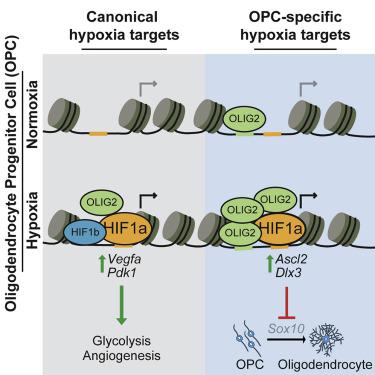Cell Stem Cell ( IF 23.9 ) Pub Date : 2020-10-21 , DOI: 10.1016/j.stem.2020.09.019 Kevin C Allan 1 , Lucille R Hu 1 , Marissa A Scavuzzo 1 , Andrew R Morton 1 , Artur S Gevorgyan 1 , Erin F Cohn 1 , Benjamin L L Clayton 1 , Ilya R Bederman 1 , Stevephen Hung 1 , Cynthia F Bartels 1 , Mayur Madhavan 1 , Paul J Tesar 1

|
Mammalian cells respond to insufficient oxygen through transcriptional regulators called hypoxia-inducible factors (HIFs). Although transiently protective, prolonged HIF activity drives distinct pathological responses in different tissues. Using a model of chronic HIF1a accumulation in pluripotent-stem-cell-derived oligodendrocyte progenitors (OPCs), we demonstrate that HIF1a activates non-canonical targets to impair generation of oligodendrocytes from OPCs. HIF1a activated a unique set of genes in OPCs through interaction with the OPC-specific transcription factor OLIG2. Non-canonical targets, including Ascl2 and Dlx3, were sufficient to block differentiation through suppression of the oligodendrocyte regulator Sox10. Chemical screening revealed that inhibition of MEK/ERK signaling overcame the HIF1a-mediated block in oligodendrocyte generation by restoring Sox10 expression without affecting canonical HIF1a activity. MEK/ERK inhibition also drove oligodendrocyte formation in hypoxic regions of human oligocortical spheroids. This work defines mechanisms by which HIF1a impairs oligodendrocyte formation and establishes that cell-type-specific HIF1a targets perturb cell function in response to low oxygen.
中文翻译:

HIF1a 的非典型靶标损害少突胶质细胞祖细胞功能
哺乳动物细胞通过称为缺氧诱导因子 (HIF) 的转录调节因子对氧气不足作出反应。尽管具有短暂的保护作用,但延长的 HIF 活性会在不同组织中产生不同的病理反应。使用多能干细胞衍生的少突胶质细胞祖细胞 (OPC) 中慢性 HIF1a 积累的模型,我们证明 HIF1a 激活非经典靶标以损害从 OPC 生成的少突胶质细胞。HIF1a 通过与 OPC 特异性转录因子 OLIG2 的相互作用激活 OPC 中一组独特的基因。非规范目标,包括Ascl2和Dlx3,足以通过抑制少突胶质细胞调节剂Sox10来阻止分化. 化学筛选显示,抑制 MEK/ERK 信号通过恢复Sox10表达而不影响典型的 HIF1a 活性,克服了 HIF1a 介导的少突胶质细胞生成阻滞。MEK/ERK 抑制还促进了人少皮质球体缺氧区域中少突胶质细胞的形成。这项工作定义了 HIF1a 损害少突胶质细胞形成的机制,并确定了细胞类型特异性 HIF1a 目标扰乱细胞功能以响应低氧。


























 京公网安备 11010802027423号
京公网安备 11010802027423号